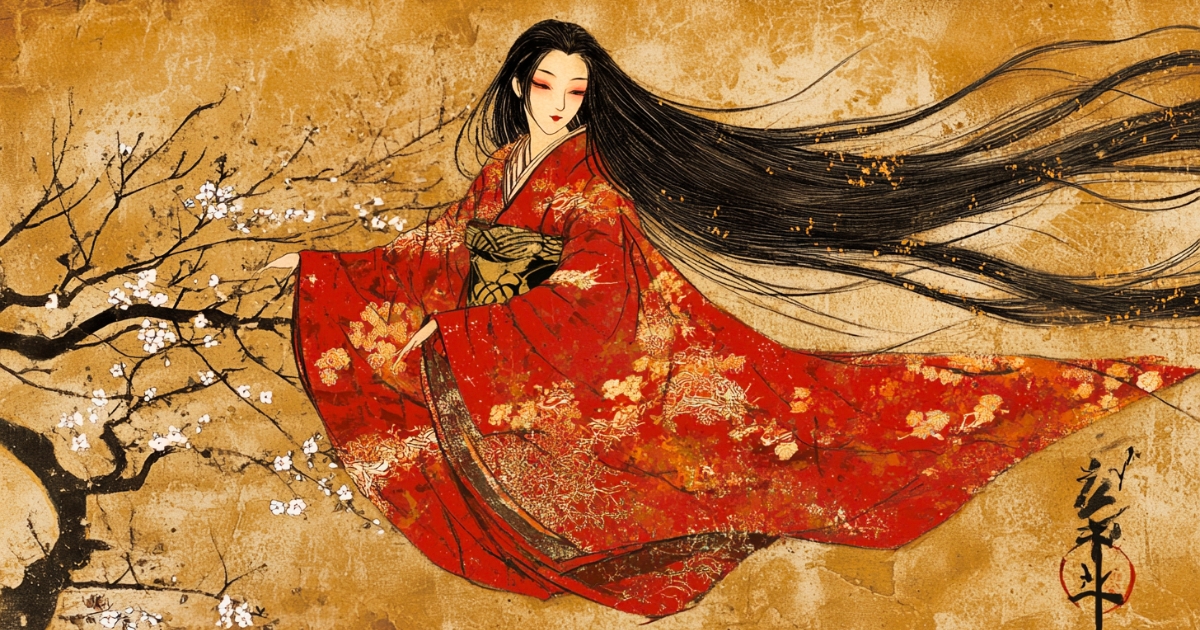The Tale of Genji, considered the pinnacle of Japanese literature, was born in the vibrant court culture of the Heian period. Its author, Murasaki Shikibu, was a female writer who flourished in the mid-Heian era, leaving an immortal masterpiece in Japanese literature through her talent and insight.
Life of Murasaki Shikibu
Murasaki Shikibu is believed to have been born around 966. Her real name is unknown, but she was called “Shikibu” because her father, Fujiwara no Tametoki, held the position of shikibu-shō. The origin of “Murasaki” is debated, but it’s likely derived from Lady Murasaki, a character in The Tale of Genji.
Showing exceptional talent from childhood, Murasaki received an unusual education for a woman of her time. While she was said to be well-versed in Chinese literature, it’s uncertain whether she learned it from her father. In her diary, The Murasaki Shikibu Diary, she notes being described as “pretentious” by others, suggesting complex feelings about her talents.
In 999, Murasaki married Fujiwara no Nobutaka, the governor of Echizen, but became a young widow when he died in 1001. Around 1004, she began serving Empress Shōshi (later wife of Emperor Ichijō), entering court life.
Writing of The Tale of Genji
The exact time when Murasaki began writing The Tale of Genji is unknown, but it’s widely believed she started in earnest after entering court service, though she may have conceived the idea earlier. The work is a 54-chapter novel set in Heian aristocratic society, centering on the life of the protagonist, Hikaru Genji.
The story begins with Genji’s birth, portraying his rise to glory, later seclusion, and the transition to the next generation. Through Genji’s life, it depicts various aspects of aristocratic society including politics, love, art, and religion, making it an encyclopedic work of the Heian period.
Characteristics and Appeal of the Work
The Tale of Genji’s greatest charm lies in its intricate psychological portrayals. Murasaki skillfully describes the subtle emotional movements of characters, showing particularly deep insight into women’s psychology, likely based on her own experiences and observations.
The story structure is also complex and multi-layered. The intertwining lives of main characters across generations create a microcosm of life itself. Japanese aesthetic sensibilities are woven throughout, including waka poetry, seasonal descriptions, and harmony with nature. Waka poetry, in particular, is a crucial element, deeply connected to character emotions and scene descriptions.
Historical Background and Social Depiction
The mid-Heian period when The Tale of Genji was written was the peak of aristocratic culture. However, it was also a time when the Fujiwara clan’s regency system was established, diminishing imperial power.
Murasaki keenly captured this zeitgeist and reflected it in her work. The novel skillfully portrays contemporary marriage and class systems, serving as a valuable resource for understanding Heian society. Buddhist thought also permeates the story, with concepts of reincarnation and impermanence strongly reflected, especially in the latter half.
Literary Influence and Evaluation
After its completion, The Tale of Genji became widely read in aristocratic society. Many commentaries were written from the late Heian period onward, and it greatly influenced subsequent literary works. Its influence can be seen in various literary genres, from the Tale of the Heike in the Kamakura period to Noh plays in the Muromachi period.
Even in modern times, many writers like Junichiro Tanizaki and Yukio Mishima have been influenced by The Tale of Genji, maintaining its important position as a source of Japanese literature.
The Tale of Genji is also highly regarded as world literature. Following Arthur Waley’s English translation beginning in the early 20th century, with the first complete translation published in 1933, it has been widely read in the West. Its depth of psychological portrayal and complex narrative structure are often compared to modern literature such as works by Proust and Joyce.
Murasaki Shikibu’s Talent and Her Era
The creation of this masterpiece was made possible not only by Murasaki’s extraordinary talent and insight but also by the social conditions of her time.
The mid-Heian period saw the spread of kana writing, enabling women to actively participate in literary activities. Many works of women’s literature, including Sei Shōnagon’s The Pillow Book, emerged during this time. Murasaki was able to cultivate her talent in this fertile literary environment.
Moreover, serving at court gave Murasaki the opportunity to observe various human interactions from within aristocratic society. These observations likely contributed to the rich human portrayals in The Tale of Genji.
Conclusion
The Tale of Genji can be considered a miraculous work born from Murasaki Shikibu’s exceptional talent and the unique background of the Heian period. Its deep human insight and rich literary quality continue to resonate with us over a thousand years later.
Through The Tale of Genji, Murasaki Shikibu depicted universal themes such as human joy, sorrow, love, and jealousy. It is not merely a story of Heian aristocrats but an eternal masterpiece capturing the essence of humanity. Even we, living in modern times, can learn and feel much from this work.
The Tale of Genji is highly valued not only as the pinnacle of Japanese literature but also as a masterpiece of world literature. The legacy left by Murasaki Shikibu will continue to be read by people around the world as a pride of Japanese culture and literature.


